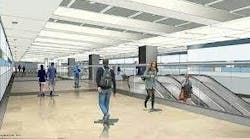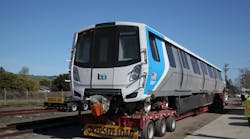BART Board approves rider-focused FY25 operating and capital budgets
The Bay Area Rapid Transit (BART) Board of Director’s approved the agency’s Fiscal Year 2025 operating and capital budgets. The budgets maintain train service levels and staffing for enhanced safety and cleaning efforts while avoiding cuts that will have a negative impact on the local economy, traffic conditions and the state of California’s climate goals.
The budgets prioritize the systemwide installation of new, taller fare gates to add an additional layer of security at stations. As the new fare gates will make it harder to skip paying the fare, the budgets continue to fund the newly increased discount for low-income riders, offering 50 percent off trips through the Clipper Start program.
“It’s more important than ever that we provide the best service possible for our nearly 200,000 riders we serve each day and to attract new riders,” said BART Board President Bevan Dufty. “This sensible budget preserves shorter wait times between trains, better weekend and evening service and, overall, more convenient public transportation to serve as an alternative to driving.”
Operating budget focuses on improvements to the rider experience
The $1.1 billion FY25 operating budget supports optimized train schedules and train lengths. BART says that with more people working from home and commuting less during the traditional rush hours, the schedule introduced in September 2023 eliminated 30-minute wait times by increasing train service during evenings and weekends while maintaining adequate daytime service on weekdays. The longest interval between scheduled trains is 20 minutes and most riders have options about every 10 minutes until 9 p.m. on weekdays.
The operating budget relies on right-sized trains to reduce costs, which BART says also results in improved safety and cleanliness. BART now operates eight-car trains on the Yellow Line, as well as selected Red and Blue line trains and six-car trains on all other lines on weekdays and weekends. BART notes the new trains have reduced traction power costs by almost 20 percent and decreases mileage on the fleet overall.
The operating budget supports BART’s focus on safety and security and ensuring police are riding trains more, increasing their visibility and deterring crime. BART Police will continue to recruit to fill all vacant officer positions and BART General Manager Bob Powers has committed to adding 19 additional officer positions once vacancies are filled. Unarmed Crisis Intervention Specialists, Ambassadors, and Fare Inspectors will continue to ride trains to boost BART’s visible safety presence.
Capital budget prioritizes reliability and reinvestment
The $1.2 billion FY25 capital budget provides funding dedicated to important rider improvements such as the Next Generation Fare Gate program, escalator replacement, new train cars and Measure RR rebuilding projects.
The capital budget is designed to be a flexible spending plan, with the ability to adapt to changing priorities and project schedules, yet retains a central focus: 98 percent of BART’s planned capital investment in FY25 and FY26 will be in System Reinvestment – investments to keep BART’s existing system reliable and safe – and Service & Capacity Enhancement – investments to enhance the rider experience, support more frequent service and add system redundancy to improve reliability.
Manageable near-term outlook
BART notes that while the FY25 operating budget is balanced, the FY26 operating budget faces a $35 million dollar deficit. Measures are being taken to reduce the projected deficit, such as containing discretionary expenses. A 5.5 percent inflation-based fare increase on January 1, 2025, combined with an identical fare increase this past New Year’s Day, is estimated to generate an additional $20 million during the two-year budget term. BART will also defer some operating budget allocations to capital projects.
“We have a number of options still available to address the FY26 operating deficit,” said BART Assistant General Manager for Performance & Budget Pamela Herhold. “We’ll be working with the board throughout the coming year to chart the best course of action.”
Uncertainty mid and long-term outlook
BART says the outlook after FY26 changes dramatically, as the agency is expected to exhaust the remaining emergency federal and state funding. One-time federal emergency assistance of $1.6 billion has allowed BART to sustain operations since 2020 but the last of this funding will be spent in FY25. SB 125 state and regional assistance of $352 million, to be allocated in 2024 and 2025, will also be used to offset operating deficits during the FY25 and FY26 budget period.
In FY27, BART’s first fiscal year without emergency assistance, the deficit is projected to be $385 million. Since BART’s outdated model of relying on passenger fares to pay most operating costs is no longer feasible, the agency must modernize its funding sources to better match other transit systems throughout the country that receive larger amounts of public funding. BART needs a more reliable long-term source of operating funding and continues to advocate at the federal, state, and regional levels for the permanent funding needed to sustainably provide the quality transit service the Bay Area needs.





